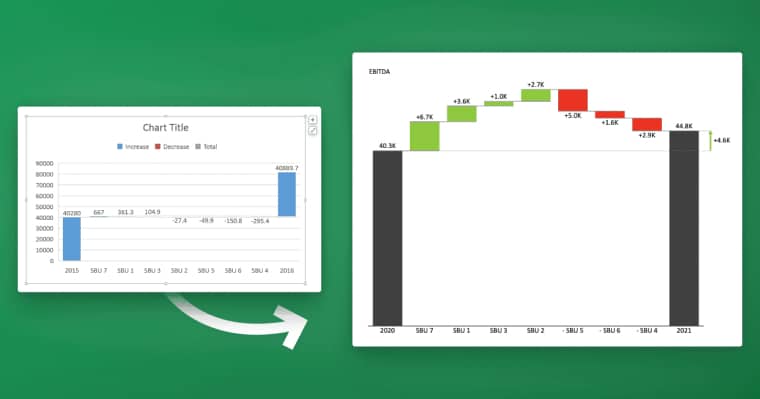Excel is a popular tool for creating visualizations of data. If you are looking to create a Vertical Waterfall Chart in Excel, there are a few things you need to know. In this article, we will discuss everything from understanding the purpose of a Vertical Waterfall Chart to customizing your chart with formatting options. We will also cover tips and tricks for designing an effective Vertical Waterfall Chart in Excel and troubleshooting common issues along the way. So, let’s dive in!
Table of Contents
Understanding the purpose of a Vertical Waterfall Chart
A Vertical Waterfall Chart is a visual representation of changes in data over time or across categories. This type of chart is commonly used to show the change in a financial account balance, but it can be used for many other purposes as well. The chart consists of bars that represent positive or negative values and connect to show the cumulative effect of each bar. The final result is a waterfall-like shape that makes it easy to identify the net change in the data set.
One of the benefits of using a Vertical Waterfall Chart is that it allows for easy identification of the largest contributors to the net change. This can be particularly useful in financial analysis, where it is important to understand the factors that are driving changes in account balances. Additionally, the chart can be customized to include additional information, such as annotations or labels, to provide further context for the data being presented.
Another advantage of using a Vertical Waterfall Chart is that it can be used to compare multiple data sets side-by-side. By using different colors or patterns for each data set, it is easy to see how they compare to each other and to identify any trends or patterns that may be present. This can be particularly useful in market analysis, where it is important to understand how different products or services are performing relative to each other.
Gathering and organizing data for your chart
To create a Vertical Waterfall Chart, you need to have the data that you want to use. This data should be organized in a way that makes sense for your chart. You can use Excel’s built-in tools to sort and filter your data so that you can easily see the changes over time or across categories. It is important to note that a Vertical Waterfall Chart requires both positive and negative values in the data set, which means that you will need to account for gains and losses in your data.
When gathering data for your chart, it is important to ensure that the data is accurate and reliable. This means that you should double-check your data sources and verify that the information is up-to-date. Additionally, you may need to clean your data by removing any duplicates or errors that could affect the accuracy of your chart.
Another important consideration when organizing your data is to determine the appropriate scale for your chart. Depending on the range of values in your data set, you may need to adjust the scale of your chart to ensure that all data points are visible and accurately represented. This can be done by adjusting the axis labels and tick marks in your chart.
Setting up your Excel worksheet for a Vertical Waterfall Chart
Once you have your data organized, you can start setting up your Excel worksheet for a Vertical Waterfall Chart. This involves setting up the columns and rows that will contain your data and creating a chart area for your chart. You should also set up any labels or titles that you want to include in your chart so that you can easily identify the data when looking at the chart.
It is important to note that when setting up your Excel worksheet for a Vertical Waterfall Chart, you should ensure that your data is accurate and up-to-date. Any errors or inconsistencies in your data can lead to inaccurate chart results. Additionally, you may want to consider using conditional formatting to highlight certain data points or trends in your chart.
Another useful tip when setting up your Excel worksheet for a Vertical Waterfall Chart is to use formulas to calculate the values for your chart. This can save you time and ensure that your chart is always up-to-date with the latest data. You can use formulas such as SUM, AVERAGE, and COUNT to calculate the values for your chart, and then simply update the formula as your data changes.
Selecting the data range for your chart
After setting up your worksheet, you can select the data range that you want to use for your Vertical Waterfall Chart. This will involve selecting the columns and rows that contain your data, and then highlighting the range that you want to use for your chart. Excel will use this data range to create the chart, so make sure that it includes all the data that you want to use.
It is important to note that if you add or remove data from your selected range, the chart will automatically update to reflect these changes. However, if you want to add additional data to your chart, you will need to update the data range manually by selecting the new range and updating the chart data source. This can be done by right-clicking on the chart and selecting “Select Data” from the drop-down menu.
Creating a stacked column chart in Excel
The next step is to create a stacked column chart in Excel. This type of chart is similar to a Vertical Waterfall Chart, but it does not show the cumulative effect of each bar. Instead, it shows the data for each category or time period separately. To create a stacked column chart, you will need to select the data range that you want to use and then select the stacked column chart option from the chart menu in Excel.
Once you have created your stacked column chart, you can customize it to better suit your needs. You can change the colors of the bars, add labels to the axes, and even add a title to the chart. To do this, simply click on the chart and then use the formatting options in the Chart Tools menu.
Another useful feature of stacked column charts is that you can easily compare the data for different categories or time periods. For example, if you are tracking sales data for different regions, you can use a stacked column chart to see how each region is performing over time. This can help you identify trends and make informed decisions about where to focus your efforts.
Converting your stacked column chart into a Vertical Waterfall Chart
Once you have created a stacked column chart, you can convert it to a Vertical Waterfall Chart. To do this, you will need to add a new series to the chart that represents the cumulative effect of each bar. You can do this by selecting the “Edit Data” option from the chart menu, selecting the empty cell at the end of the data range, and then entering a formula that adds up the values of all the previous cells. You can then format this series to use a different color or style so that it is easily identified as the cumulative effect.
Customizing your Vertical Waterfall Chart with formatting options
After creating your Vertical Waterfall Chart, you can customize it with various formatting options. These options include changing colors, fonts, axis labels, and more. You can also add additional data series to the chart to show different aspects of the data. For example, you could add a series that shows the percentage change in the data over time or across categories.
Adding labels and axis titles to your chart
To make your Vertical Waterfall Chart easier to understand, it is important to add labels and axis titles. These labels should clearly identify the data and explain any abbreviations or acronyms that are used. You should also include a title for the chart that describes what it is showing and the time period or categories that are being used.
Analyzing and interpreting data using your Vertical Waterfall Chart
Once you have created a Vertical Waterfall Chart, you can use it to analyze and interpret your data. This involves looking at the changes over time or across categories and identifying any trends or patterns that emerge. You can also use your chart to compare different data sets and see how they differ in terms of gains and losses.
Tips and tricks for designing an effective Vertical Waterfall Chart in Excel
When designing a Vertical Waterfall Chart in Excel, it is important to keep a few tips and tricks in mind. First, make sure that your chart clearly shows the changes in your data over time or across categories. Use colors and labels to make it easy to understand. Additionally, consider using Excel templates to save time and ensure consistency across multiple charts.
Troubleshooting common issues when creating a Vertical Waterfall Chart
Creating a Vertical Waterfall Chart can be a complex process, and there are many issues that can arise along the way. Some of the most common issues include missing or incorrect data, formatting problems, and errors in formulas. If you encounter any issues when creating your chart, try to isolate the problem and find a solution before moving on.
Comparing the advantages of using a Vertical Waterfall Chart over other types of charts
Although there are many types of charts that can be used to visualize data, a Vertical Waterfall Chart has several advantages. First, it clearly shows both gains and losses in a data set, which makes it easy to understand. It also shows the cumulative effect of each change, which provides a more complete picture of the data. Other types of charts, such as line or bar charts, may not provide this level of detail.
Using templates to create multiple Vertical Waterfall Charts with ease
To save time and ensure consistency across multiple charts, consider using templates when creating Vertical Waterfall Charts in Excel. Excel templates are pre-designed worksheets that can be customized to fit your specific needs. Using a template can help you create multiple charts quickly and easily, and can also ensure that your charts are consistent in terms of formatting and style.
Sharing and presenting your Vertical Waterfall Chart with others in person or online
Once you have created your Vertical Waterfall Chart, you can share it with others in person or online. If you are presenting the chart in person, make sure that it is clear and easy to read from a distance. If you are sharing the chart online, consider using a tool like Microsoft Teams or Zoom to share your screen and walk viewers through the chart step-by-step.
Creating a Vertical Waterfall Chart in Excel can be a powerful way to visualize changes in data over time or across categories. By following these steps and tips, you can create an effective chart that provides a clear picture of your data and helps you identify trends and patterns. Happy charting!














